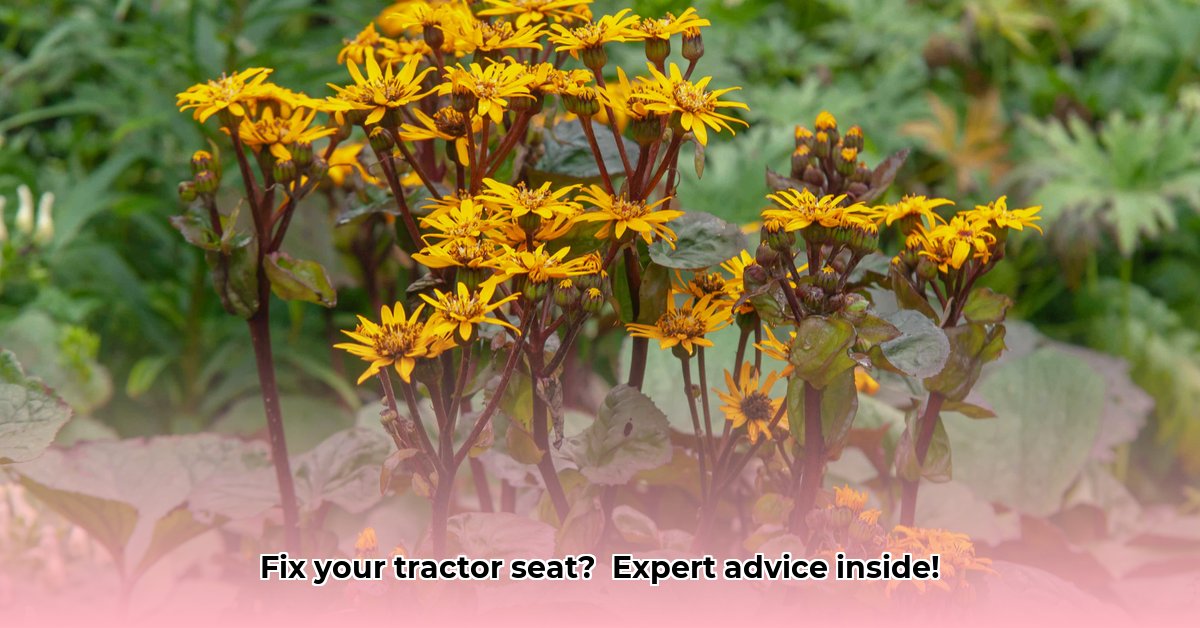
Tractor Seat Plant Problems: A Troubleshooting Guide
Growing Ligularia reniformis, also known as tractor seat plants, can present unique challenges. This guide provides solutions to common problems to help you cultivate healthy, vibrant plants. For those needing replacement parts, check out these tractor seat replacements.
Decoding the Distress Signals: Identifying Plant Issues
Before addressing problems, accurately identify the issue.
Droopy, Yellowing Leaves: This often indicates improper watering. Check soil moisture; dry soil needs watering, while waterlogged soil suggests overwatering and potential root rot. A simple finger test (inserting your finger an inch or two into the soil) can determine moisture levels.
Damaged Leaves & Trails: Holes or chewed edges, alongside shiny trails, point to pests like slugs or insects. Identifying the culprit is crucial for effective treatment.
Winter Damage: Frost can severely damage or kill tractor seat plants in colder climates. Winter protection is essential for survival.
Addressing Tractor Seat Plant Problems: Practical Solutions
Once you've identified the problem, follow these steps:
1. Watering Wisdom: Achieving the Right Moisture Balance
Overwatering (Soggy Soil): Improve drainage by amending heavy clay soils with compost or other organic materials, allowing excess water to drain. Increase the time between waterings.
Underwatering (Dry Soil): Water more frequently, especially during hot, dry periods. A layer of mulch around the plant helps retain soil moisture, reducing watering frequency.
2. Pest Patrol: Effective Pest Control Strategies
Slug Control: Use commercially available slug bait placed near the plant base. Copper tape around the pot or plant base can act as a physical barrier.
Insect Control: Apply insecticidal soap or neem oil, following product instructions carefully. These are generally less harmful to beneficial insects than harsher chemicals. Organic options also exist.
3. Frost Protection: Safeguarding Your Plants from Cold Temperatures
Mulching: Apply a thick layer of mulch around the base of the plant to insulate the roots from freezing temperatures.
Winter Coverings: During severe cold spells, cover the plant with a frost blanket, old sheets, or towels for added insulation.
How to Prevent Tractor Seat Plant Frost Damage
Key Takeaways:
- Understanding seasonal weather patterns is vital for protecting your tractor seat plants from frost damage.
- Proactive monitoring and preventative measures significantly reduce the risk of frost damage.
- Proper plant protection maximizes yield and plant health.
- Simple preventative steps significantly minimize the chance of crop losses.
- Combining preventative and reactive measures offers the most effective frost protection.
Understanding the Threat of Frost
Frost poses a significant threat, causing irreversible damage through ice crystal formation within plant tissues. This leads to wilting, discoloration, and ultimately, plant death. Regularly check local weather forecasts, paying close attention to temperatures below freezing (0°C or 32°F). Even light frosts can harm plants.
Protecting Your Tractor Seat Plants from Frost: A Step-by-Step Guide
Temperature Monitoring: Use a thermometer to track nighttime lows, enabling timely protective measures.
Strategic Watering: Avoid overwatering, which increases frost vulnerability. Water deeply but less frequently, maintaining moist but not soggy soil.
Site Selection: Plant in a location providing natural protection. South-facing slopes retain more heat, and sheltered areas reduce frost risk.
Mulching: Apply a substantial layer of mulch (straw, wood chips, etc.) around the plant base to insulate the soil.
Plant Covering: On frosty nights, cover plants with frost cloths, blankets, or inverted containers to trap heat. This is a simple, effective protective method.
Relocation (Container Plants): Move container plants indoors or to a sheltered location overnight when frost is predicted.
Cold Frames/Greenhouses: Consider cold frames or greenhouses for optimal protection and extended growing seasons, given their controlled environment.
Post-Frost Care and Damage Assessment
After a frost, promptly inspect your plants for wilting, discoloration, or mushy areas. Remove severely affected parts. Minor damage may allow for recovery with proper care. Continue monitoring and adjust your protection strategies accordingly.
Addressing Common Frost-Related Problems
- Wilting: Indicates water loss from frost damage. Gently water, avoiding waterlogging, to aid recovery.
- Discoloration: Brown or black spots signify cell damage; remove severely affected areas.
- Plant Death: Extensive damage might necessitate replacing plants. Review your frost protection strategies for improvement.
Preventing frost damage is far more effective than remediation. Consistent weather monitoring and the preventative measures outlined above will ensure healthy, thriving tractor seat plants.